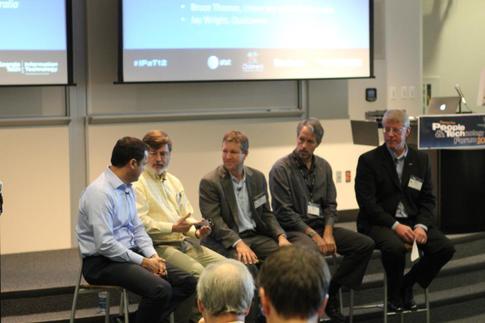At a panel last week on “Mobile Devices and Beyond,” Bruce Thomas, director of the Wearable Computer Lab at the University of South Australia, held up his smartphone and said: “I just want to get rid of this.”
While many are running to catch up to the explosion of smartphone use, those in the vanguard of mobile are already considering what happens when your cell phone explodes.
And when it’s part of a “body network.”
And when its role becomes one of connecting other devices to data networks.
And, oh, Chester Gould had it wrong, the Dick Tracy wristwatch is not in our personal communications future. Wristwatches as technology for telling time and more got supplanted by cell phones. Wristwatches: More jewelry than tech.
Thomas was on a panel Tuesday at the “People and Technology Forum 2012” at the Georgia Tech.
While the panelists weren’t unanimous in their views on the future role of the cell phone, it does appear those working on the next generation of computing devices that we will carry – or even wear – see a disaggregation of the cell phone: the screen may move to glasses, the battery to your belt or even a shoe; and some of its apps moving to specialized devices talking to your cellphone.
The “glass brick” is not going away anytime soon, said Jay Wright, vice president of business development for chip maker Qualcomm. But he does see over the next five to eight years “slave devices,” input devices for the phone and more robust body area networks.
Thomas sees the disaggregation of the cellphone happening in seven or eight years.
“Having devices for specific purposes will become more common,” said John Avery, Engineering Group Manager for the Panasonic Innovation Center across the street from Georgia Tech, where the future of cell phone and computer technologies for cars is being envisioned.
What else is coming? Better voice controls, including the ability to listen for commands all the time, not just when you push a button. Another: The ability to control the phone with gestures seen by the camera. And every surface of the phone could be part of the “screen.” The viewing landscape may also change with more augmented technology built-in.
Longer battery life, however, is not moving at the same pace as the computer power. In fact, increased capabilities have resulted in dramatically shorter battery life. “Sometimes we over-feature things,” Thomas said.
Photo: “Mobile Device & Beyond” panel- Bruce Thomas, Director, Wearable Computer Lab University of South Australia & Jay Wright, Vice President, Business Development at Qualcomm discuss future of mobile devices & wearable computing — at Georgia Tech Global Learning Center. (Georgia Tech Photo)
